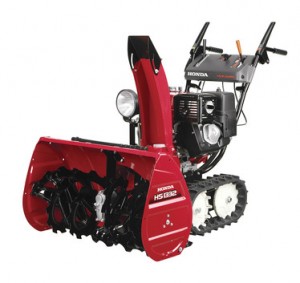 When it comes to making sure that the Honda HS1132 snowblower can perform powerfully and efficiently for many years to come, nothing is more important than regular maintenance. Whether it’s preventative procedures that keep the engine in top shape, or restorative processes that replace parts and maximize efficiency, maintenance is absolutely the most important aspect of power equipment ownership. Those new to Honda snowblowers or power equipment in general should keep in mind a few basic areas of concern throughout the winter and during off-season storage preparations.
When it comes to making sure that the Honda HS1132 snowblower can perform powerfully and efficiently for many years to come, nothing is more important than regular maintenance. Whether it’s preventative procedures that keep the engine in top shape, or restorative processes that replace parts and maximize efficiency, maintenance is absolutely the most important aspect of power equipment ownership. Those new to Honda snowblowers or power equipment in general should keep in mind a few basic areas of concern throughout the winter and during off-season storage preparations.
Before Maintenance, Double-Check All Safety Procedures
Snowblower maintenance takes place amid numerous risks of serious injury. Like all snowblowers, the HS1132 comes with a powerful engine, numerous moving parts, and sharp implements that can cause significant problems for equipment owners who don’t follow a strict set of safety guidelines. When conducting maintenance, always make sure that the equipment has cooled down after recent use. Place the equipment in a well-ventilated or outdoor area, and make sure that it’s resting on a flat, level, and solid surface so that fuel spills and damage are less likely to occur. Make sure that bystanders and pets have left the area before proceeding in order to minimize their risk of injury as well.
Key Areas of Concern During Maintenance
Snowblowers experience wear and tear in several key areas during regular use, each of which represents a key area of concern for equipment owners. Generally, the following areas should be subject to inspection prior to each snowblower outing:
– Fuel and oil levels
– Auger and auger housing
– Engine
– Scraper
The included maintenance schedule, which can be found in the HS1132’s operator manual, also indicates several other key areas that should be checked incrementally. From belts to bolts and beyond, each of these areas benefits from regular maintenance and a preventative approach.
Recommendations for Snowblower Fueling
Honda’s engines are generally designed to work best with unleaded gasoline. More specifically, a high-octane fuel should be used in order to ensure the highest level of engine operation and efficiency throughout the winter. Gasoline with a minimum 86 octane rating should always be used to power the snowblower, and Honda further recommends fuel that comes with no more than 10 percent ethanol or 5 percent methanol.
Engine Oil: Key Information to Know During the Winter
Honda’s maintenance schedule recommends checking the engine’s oil level prior to each use of the snowblower, largely to prevent unnecessary engine damage. Regular checks also help to guard against an unnoticed oil leak, which could be even more damaging and expensive. If oil needs to be refilled, the snowblower should always use 5W30 oil. This oil is designed for superior performance in especially cold temperatures, making it easier on the engine and more efficient overall.
Oil changes should be done according to the interval specified in the operator manual, typically no more than 100 hours apart. To drain oil, use a wrench to loosen the drain plug and sealing washer, as well as the drain plug extension, and make sure the lubricant drains into an appropriate disposal container.
Transmission Fluid Concerns
Like the engine oil, hydrostatic transmission fluid should be checked before using the snowblower after each winter storm. The company has included a dipstick that includes “upper” and “lower” measurement levels, which makes it easy to measure the fluid even if the equipment hasn’t been warmed up and recently used. Generally, cold transmission fluid should either meet or exceed the “upper” notation. Warm transmission fluid should meet or exceed the company’s “lower” line on the dipstick.
Snowblower Spark Plug Maintenance
Regular cleaning of the spark plug will allow the engine to both start and operate a bit more efficiently. Start by removing the spark plug cap, and then removing the spark plug entirely. Clean any dirt that may have built up around the spark plug and the cap, and be sure to clear away any carbon deposits that might have occurred since the last time the spark plug was cleaned.
After cleaning the area around the spark plug, be sure to inspect the spark plug itself for any damage that might have occurred during snow clearing. If the spark plug appears to be significantly damaged, replace it with an OEM model from Honda as soon as possible.
Be Sure to Conduct a Regular Tire Inspection
Before each use of the snowblower, it’s important to check the tires and make sure that they’re proper inflated, free of damage, and not showing any signs of cracking. Cold weather can be especially hard on these tires; if any damage is noticed, either replace the tires or make sure their air pressure level is in line with Honda’s recommendations.
Prioritize an Auger and Blower Inspection
Keeping the snowblower’s auger and blower in good condition is absolutely essential to the equipment’s functions. Before each use of the equipment, check the auger for compacted snow or ice, debris, and dirt. Use a snow clearing bar to remove any obstructions if the need arises. Also make sure that the blower is properly in position, without damaged parts or adjustment required.
Get Maintenance Done with OEM Honda Parts from HondaLawnParts.com
The best way to ensure the long-term durability of a Honda HS1132 snowblower is to use OEM parts, like those found at HondaLawnParts.com. Using an online search tool, customers can easily find the exact part that matches their snowblower’s model number, engine type, or the specific part number in need.
